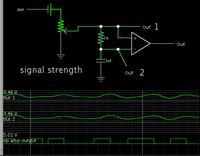neazoi
Advanced Member level 6
Hello this is a nice antenna http://www.techlib.com/electronics/antennas.html (the first schematic) I have tried.
It is a tuned loop and needs retuning every 5-10KHz or so. Tuning is done by varying the voltage to the varactor using the pot. Tuning is done by observing the strongest audio signal (noise) on the receiver that the antenna is connected to.
I Wonder if there is a clever trick one could use in order to automatically tune the antenna, mased on this noise?
It is a tuned loop and needs retuning every 5-10KHz or so. Tuning is done by varying the voltage to the varactor using the pot. Tuning is done by observing the strongest audio signal (noise) on the receiver that the antenna is connected to.
I Wonder if there is a clever trick one could use in order to automatically tune the antenna, mased on this noise?
